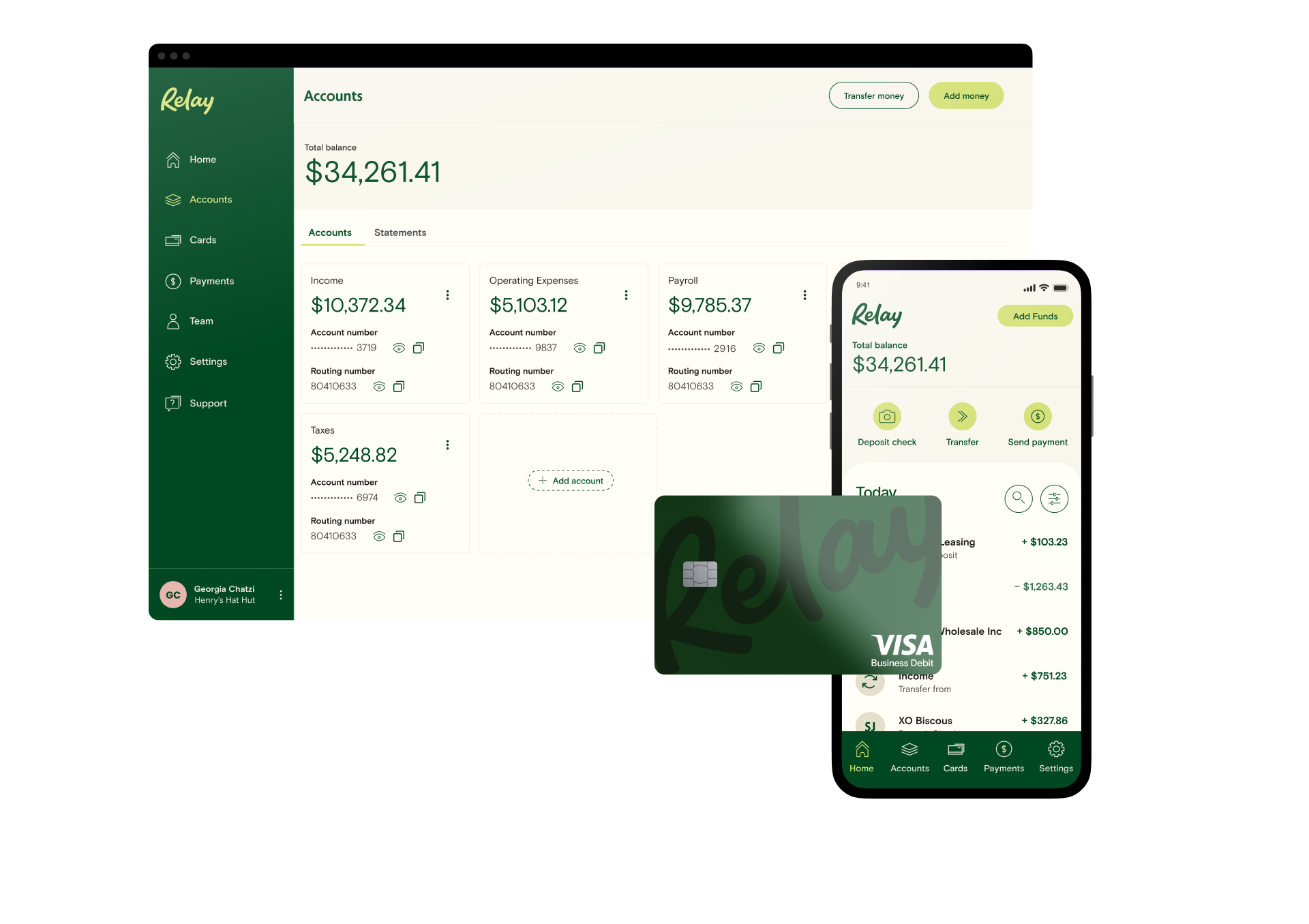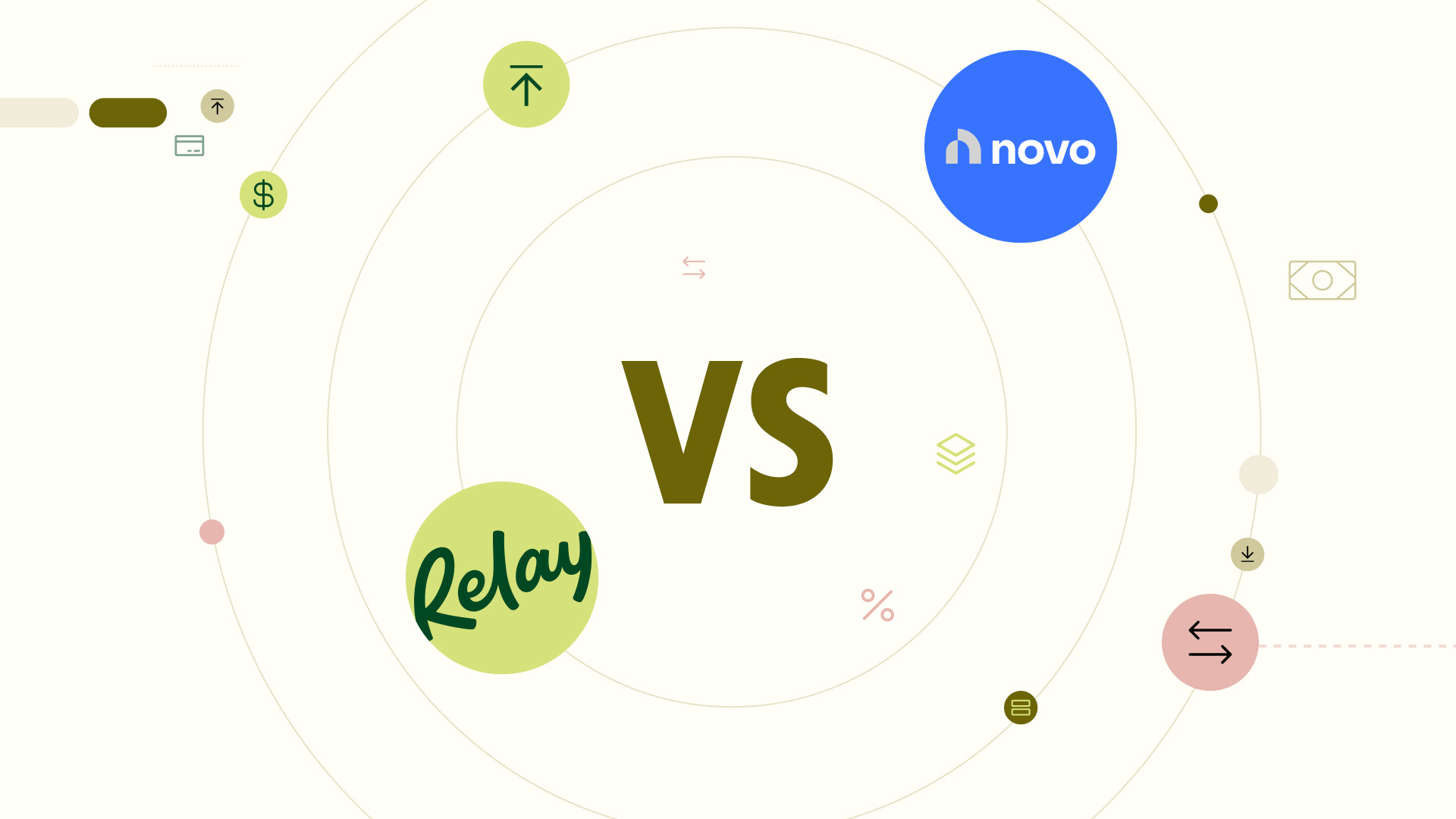With Brex announcing the end of support for small business clients by August 15, 2022, many SMBs are left looking for a business banking alternative. To help you choose the best banking option for your business, we’ve put together a quick guide that compares Brex vs. Relay. Here's what this guide covers:
Before we begin, let’s give you a brief overview of each banking platform.
🏦 What is Relay?
Relay is an online banking and money management platform that helps you stay on top of cash flow, get unparalleled clarity into operating expenses, and manage your team’s spending.
Since its founding in 2018, Relay has focused on serving small businesses and their advisors — accountants and bookkeepers. It's the ideal banking platform for businesses with 1 to 100 employees.
With Relay, businesses can create up to 20 individual checking accounts and up to 50 physical or virtual debit Mastercards® to organize income, expenses, and cash reserves.
With multiple checking accounts, businesses can stick to a set budget by creating a digital envelope system. Business owners can create dedicated accounts for single-purpose expenses — like operations and marketing — or accounts to set aside money for critical needs like taxes and payroll.
All Relay checking accounts are true checking accounts with unique account and routing numbers, which means you can automate and schedule transactions between these accounts.
Within Relay, you can easily create new physical or virtual cards with dedicated spending limits. For example, you can create an operations card and a marketing card for those expenses and link them back to their corresponding checking accounts to simplify expense tracking.
Banking Built for Business Owners
No account fees or minimums; 20 checking accounts; 2 savings accounts with 1.00%-3.00% APY; 50 virtual + physical debit cards. Open account 100% online.
Learn more💳 What is Brex?
Brex is an all-in-one financial management platform for enterprise companies and venture-backed startups. Founded in 2017, Brex offers banking services, charge cards, employee expense management automation and reporting for scaling businesses.
While Brex used to serve businesses of all sizes, on June 16, 2022, the company announced that it would stop serving tens of thousands of small business customers as part of a renewed focus on high-growth tech startups.
Businesses that are still eligible to bank with Brex can do so without needing to pay any account fees. Brex is also a good option for businesses looking to build credit. Since all Brex cards are charge cards by default, this lets businesses build a credit history as well as earn points on their purchases.
⚖️ Brex vs. Relay: What’s the difference?
The main difference between Brex and Relay is that Brex serves venture-backed startups and high-growth technology companies, whereas Relay is suited best for small employer businesses, with 1 to 100 employees, that want to get crystal clear on their cash flow. In addition, Relay does not have any minimum requirements to open an account, whereas Brex will require that your company meet certain thresholds — although these are not stated publicly.
📊 Brex vs. Relay comparison
Here are the main differences and similarities between Brex and Relay:
Feature | Relay | Brex |
|---|---|---|
Businesses of any size can open an account | ✅ | ❌ |
Type of businesses served | SMBs with 1 - 100 employees | Enterprise companies |
No monthly account fees | ✅ | ✅ |
No minimum balance requirements | ✅ | ✅ |
No overdraft fees | ✅ | ✅ |
Free ACH payments | ✅ | ✅ |
Free check payments | ✅ | ✅ |
No fees on deposits | ✅ | ✅ |
Currency exchange for international wires | ✅ | ❌ |
Domestic wires | $5 (Free with Relay Pro) | Free |
International wires | $10 (Free with Relay Pro) | Free |
Same-day ACH | ✅ (Relay Pro) | ❌ |
Free checking accounts | 20 | 8 |
Savings accounts | ✅ | ❌ |
Debit cards | ✅ (Up to 50) | ❌ |
Credit cards | ✅ | ✅ |
Cashback and rewards on card spend | ✅ | ✅ |
Accounts payable automation | ✅ (Relay Pro) | ❌ |
Request payee information | ✅ | ❌ |
Request W9 forms from payees | ✅ | ❌ |
QuickBooks Online integration | ✅ | ✅ |
Xero integration | ✅ | ✅ |
Gusto integration | ✅ | ✅ |
Trustpilot rating | 4.6 (Source) | 3.1 (Source) |
🔎 Qualifying for an account
Brex and Relay differ in how businesses qualify for an account. Relay supports all types of entities: Corporations, Multi-Member LLCs, Single-Member LLCs, Partnerships and Sole Proprietorships. In each case, the business owners must submit documents required for registration. This takes 10 minutes to complete and can be done online.
To qualify for an account with Brex, a business must be incorporated, and it must meet certain size threshold requirements. While those thresholds are determined on a case-by-case basis, Brex has indicated that some small businesses that were once qualified are no longer qualified.
🤝 Banking collaboration with accountants
Relay and Brex approach banking collaboration differently. Brex lets business owners issue read-only access to external advisors (accountants and bookkeepers), however, there are limited options when it comes to selecting a permission level.
In Relay, business owners can provide secure, role-based account access to their accountant or bookkeeper so they can manage money and cards, pay bills and access banking data and documents, like monthly statements. These permission levels include:
Administrator
Manager
Bill Payer
Bill Payer (imported bills only)
Cardholder
Deposit-only
Read-only
See here for a full list of permissions in Relay.
💵 Cashback and rewards
While Brex offers businesses cash back and rewards options on charge cards, Relay does not offer a credit product, offering only business checking accounts and debit cards. Brex’s reward program includes discounts on business apps and supplies, as well as cashback and travel points. To get the best rewards with Brex, businesses need to prove card exclusivity, otherwise, cash-back rewards are greatly diminished.
📩 Accounts payable management
The two companies take a different approach to accounts payable and spend management. Brex focuses on streamlining expense management for team members at large organizations, which means there's less focus on managing cash flow in the business overall.
For example, businesses can create expense policies for employees, and employees can request the ability to make purchases, increase limits, or get vendor-specific cards. And while Brex does not directly pull unpaid invoices from your accounting system, like Xero or QuickBooks Online, businesses can send their unpaid invoices to Brex by email.
Relay’s accounts payable solution, on the other hand, is a better fit for businesses looking to manage their cash flow and spending as a whole. The Relay Pro subscription tier automatically syncs any unpaid bills from Xero or QuickBooks Online back into Relay’s platform. From here, businesses can review, approve, and pay bills directly from Relay. In addition, businesses can set up single- or multi-step approval rules based on payment amounts.
🥁 Verdict: What’s better, Relay or Brex?
Which banking platform you choose will largely depend on whether you are a venture-backed startup, or if you are a small business that needs a banking platform that puts you in complete control of your cash flow.
If you qualify, Brex offers a ton of perks and cashback on card spend and is a great fit for enterprise businesses that require robust employee spend management.
On the other hand, Relay is online banking that puts businesses of all sizes — whether you’re small, big, bootstrapped, venture-backed, or anything in between — in control of their finances. In particular, Relay is a strong fit for companies trying to build a cash flow-positive business — helping them set and stick to sustainable budgets by organizing income, expenses, and reserves into dedicated accounts.
If you recently had your Brex account closed because you no longer meet the company's requirements, Relay is here for you. Sign up for Relay here!




